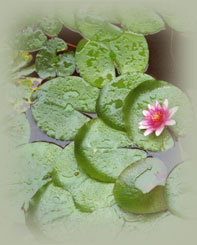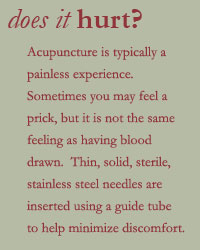| |

 Acupuncture
is among the oldest healing practices in the
world. As part of traditional Chinese
medicine, it is a family of procedures that
stimulate anatomical points on the body, most
commonly by penetrating the skin with thin,
solid, metallic needles that are manipulated by
the hands or by electrical stimulation Acupuncture
is among the oldest healing practices in the
world. As part of traditional Chinese
medicine, it is a family of procedures that
stimulate anatomical points on the body, most
commonly by penetrating the skin with thin,
solid, metallic needles that are manipulated by
the hands or by electrical stimulation
For thousands of years,
traditional Chinese medicine has held that
health is maintained when two opposing and
inseparable forces achieve harmony – yin and
yang. Yin is the cold, slow or passive aspects
of self, and yang is the hot, excited or active
aspects. Disease can be the result of an
imbalance of yin and yang, leading to a blockage
in the flow of qi – one’s vital energy or life
force.
 Oriental
medicine theories propose that qi can be
unblocked by using acupuncture at certain points
on the body that connect with meridians, or qi
pathways. Such pathways may criss-cross
throughout the body to create at least 2000
interaction, or acupuncture, points. Oriental
medicine theories propose that qi can be
unblocked by using acupuncture at certain points
on the body that connect with meridians, or qi
pathways. Such pathways may criss-cross
throughout the body to create at least 2000
interaction, or acupuncture, points.
Acupuncturists look at the
body as a whole to discover how these
pathways—which embody the mind, body and
spirit—interact. Just as experiencing too much
of one emotion might lead to a physical problem;
an imbalance in the body might lead to mental or
spiritual disharmony. When acupuncture regulates
one aspect, it will automatically harmonize the
others.
|
The World Health Organization considers
acupuncture appropriate for the following
ailments:
| Acne |
High blood pressure |
| Arthritis |
Hypoglycemia |
| Asthma |
Impotence |
| Back pain |
Indigestion |
| Bronchitis |
Infertility |
| Bursitis |
Irregular period or Cramps |
| Colds and flus |
Morning sickness |
| Colitis |
Neuralgia |
| Constipation |
PMS |
| Deafness |
Ringing in the ears |
| Diabetes |
Sciatica |
| Diarrhea |
Stiff neck |
| Dizziness |
Stroke |
| Exzema |
Tendonitis |
| Headaches |
Ulcers |
| Hepatitis |
Vaginitis |
| Hemorrhoids |
|
| Herpes |
|
|